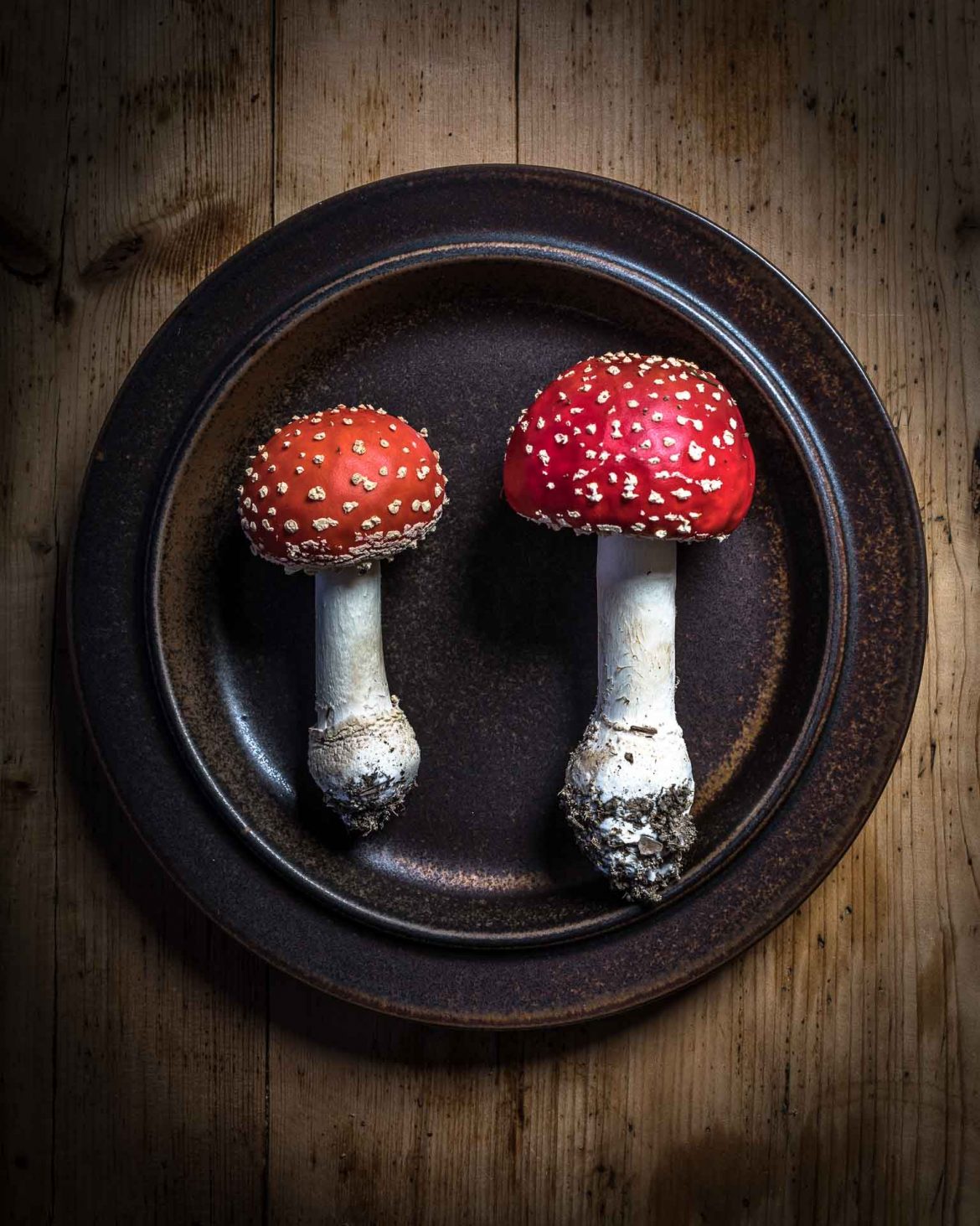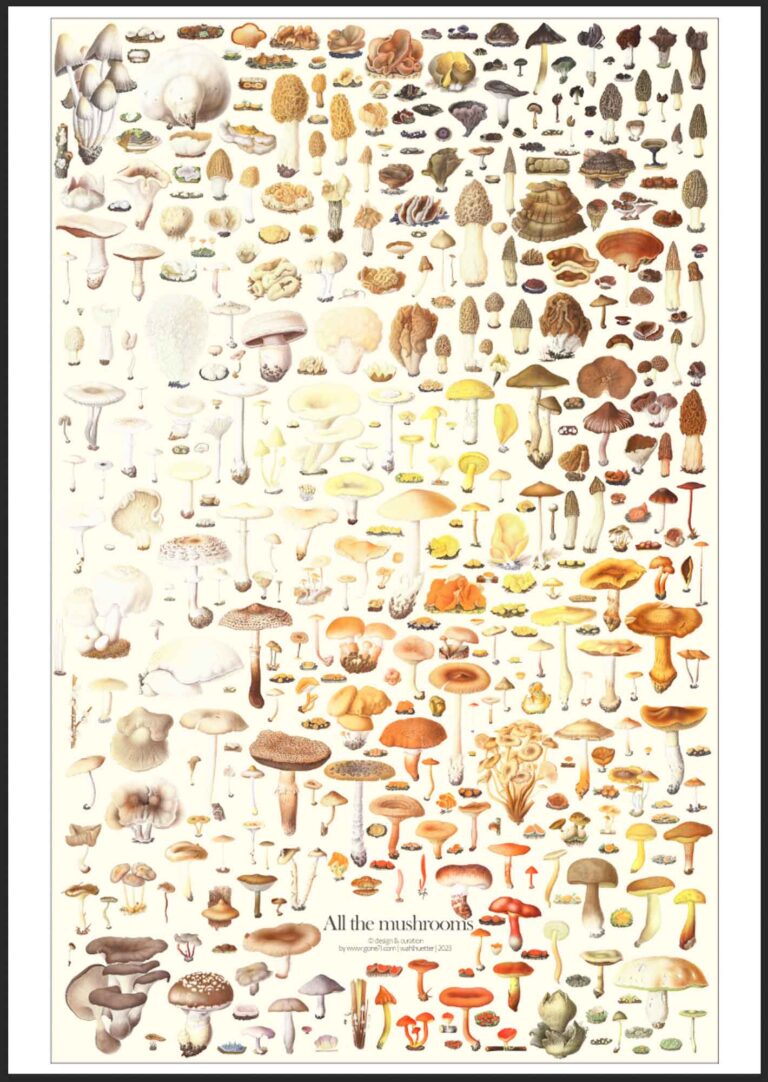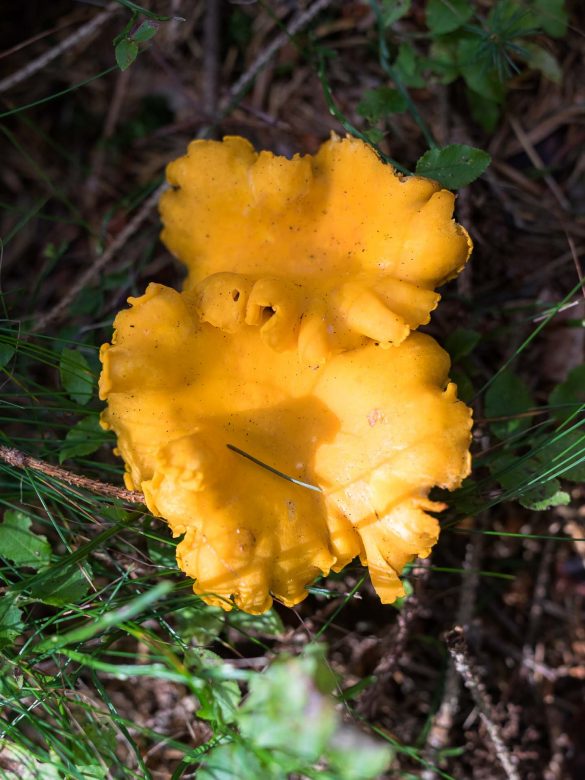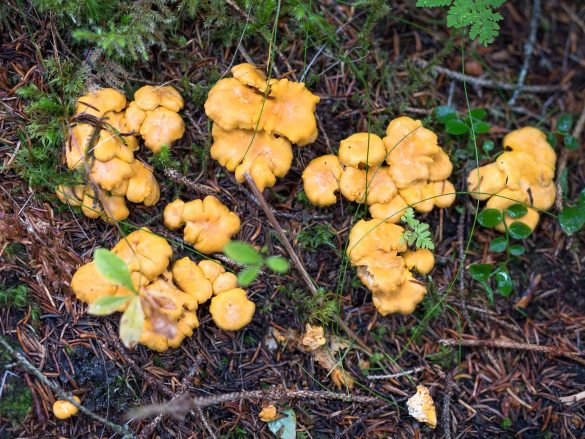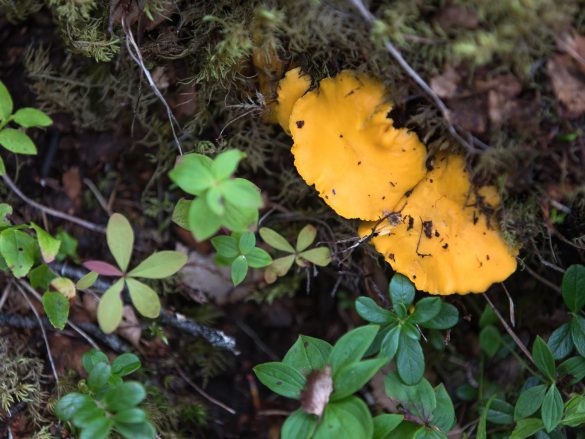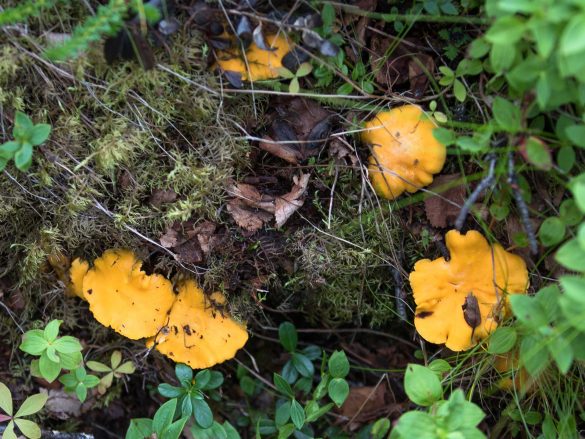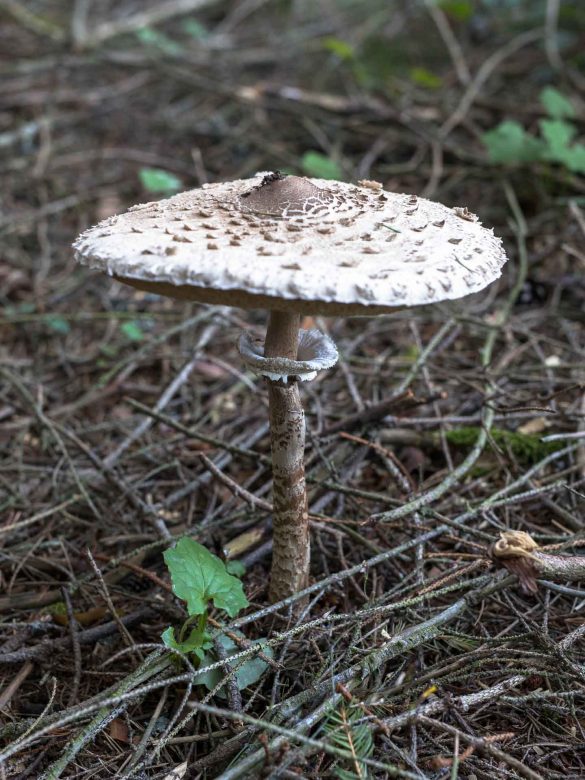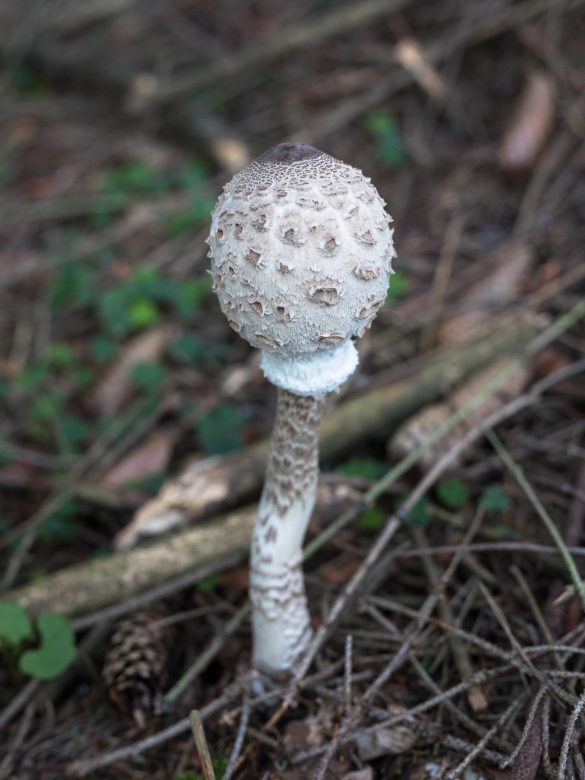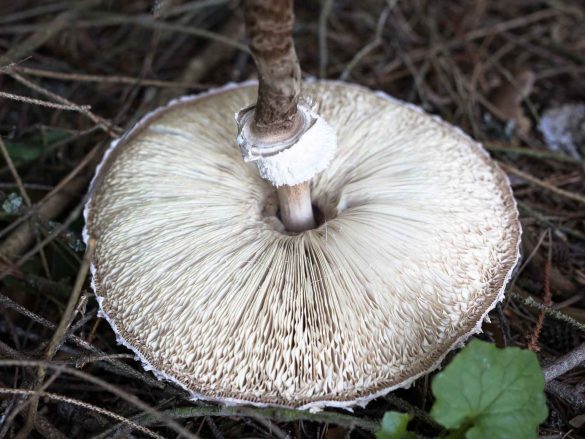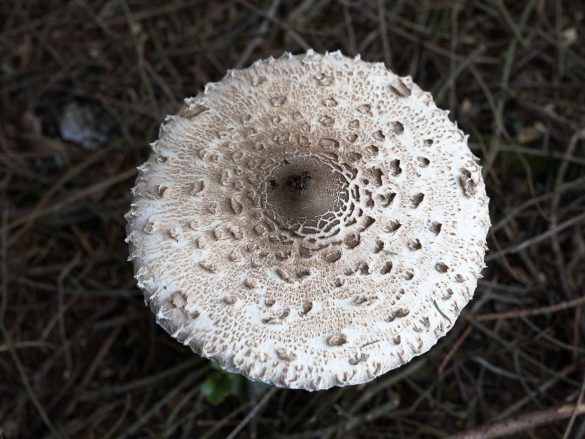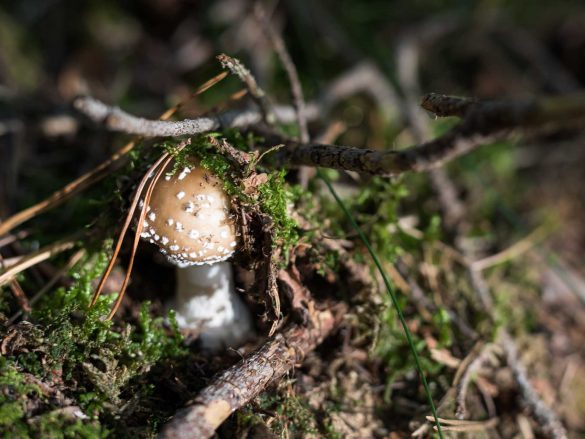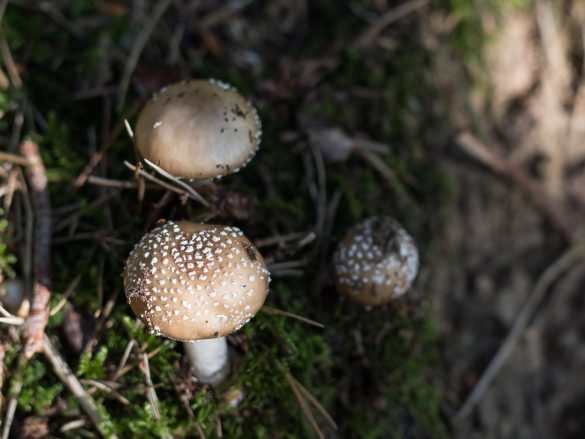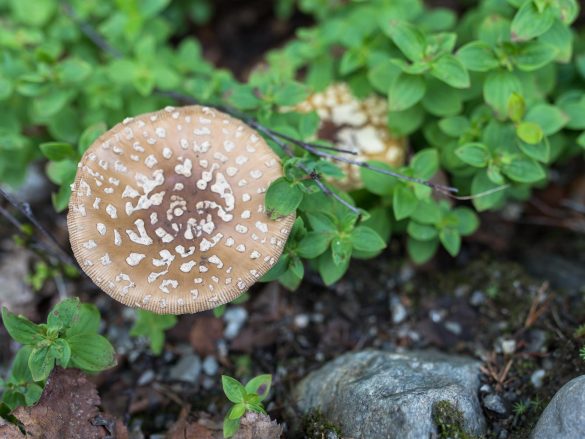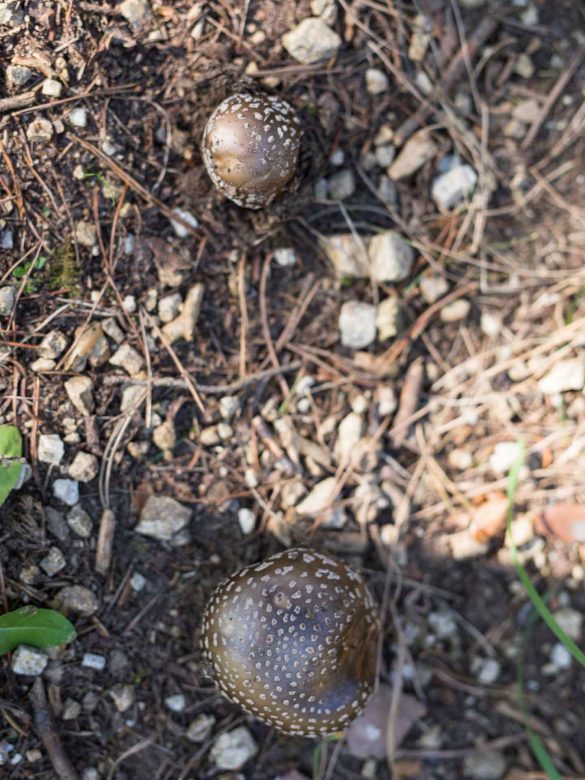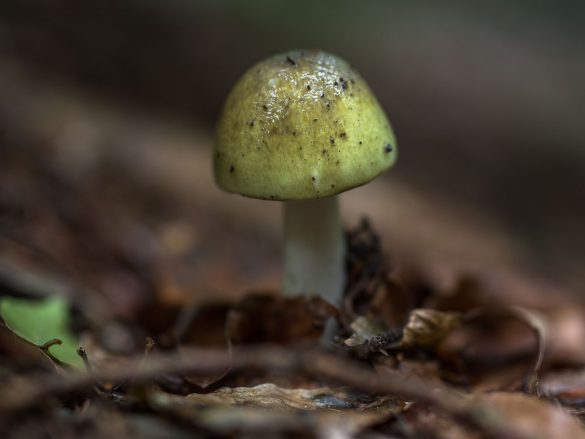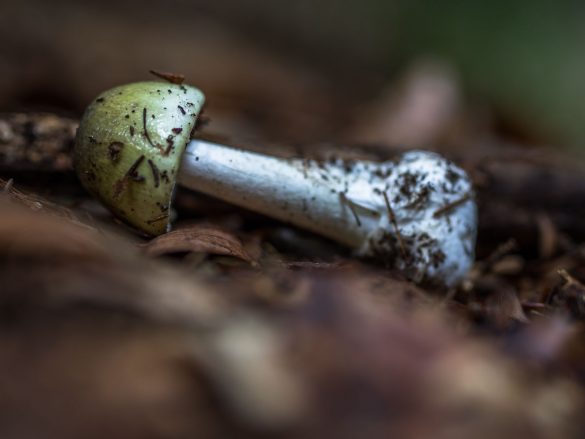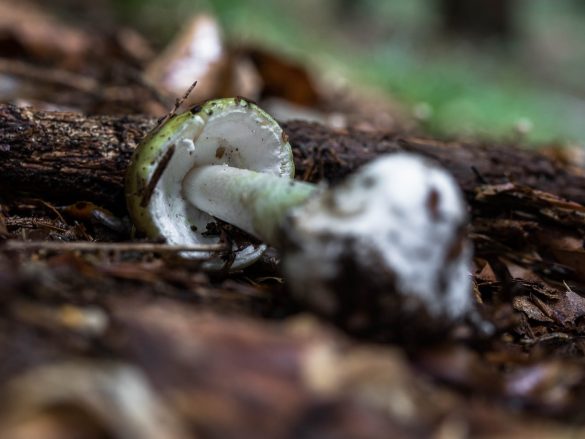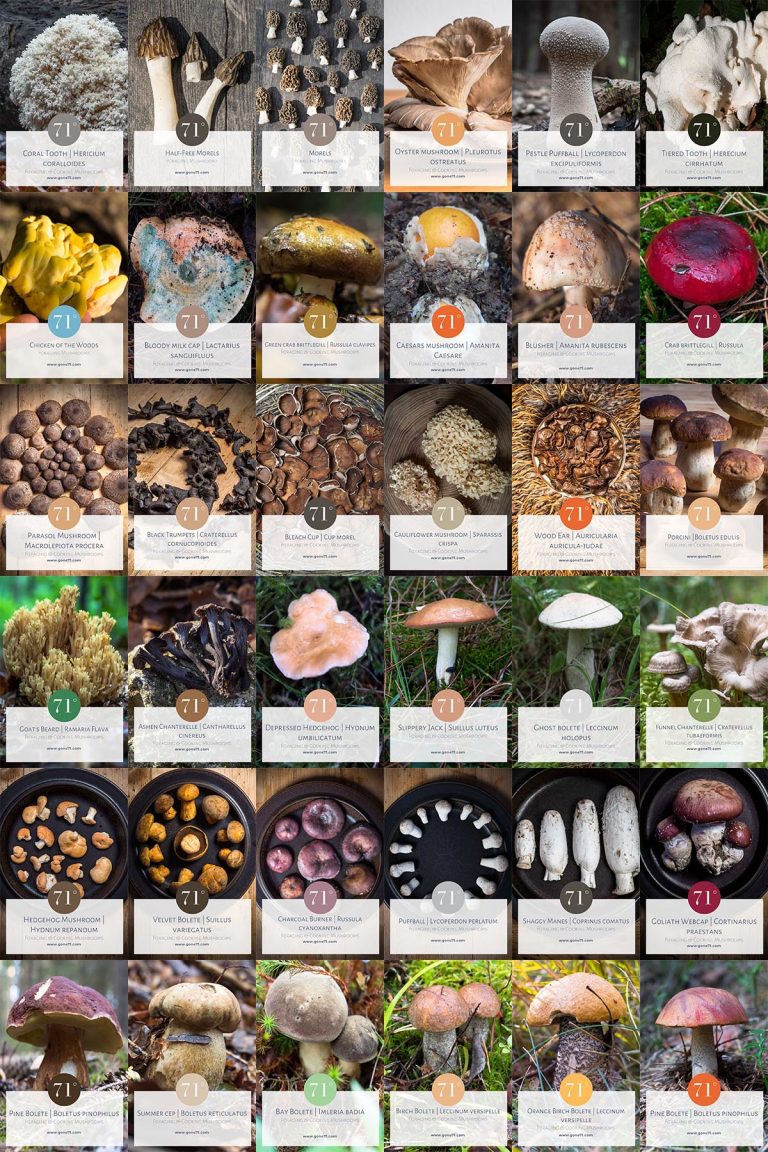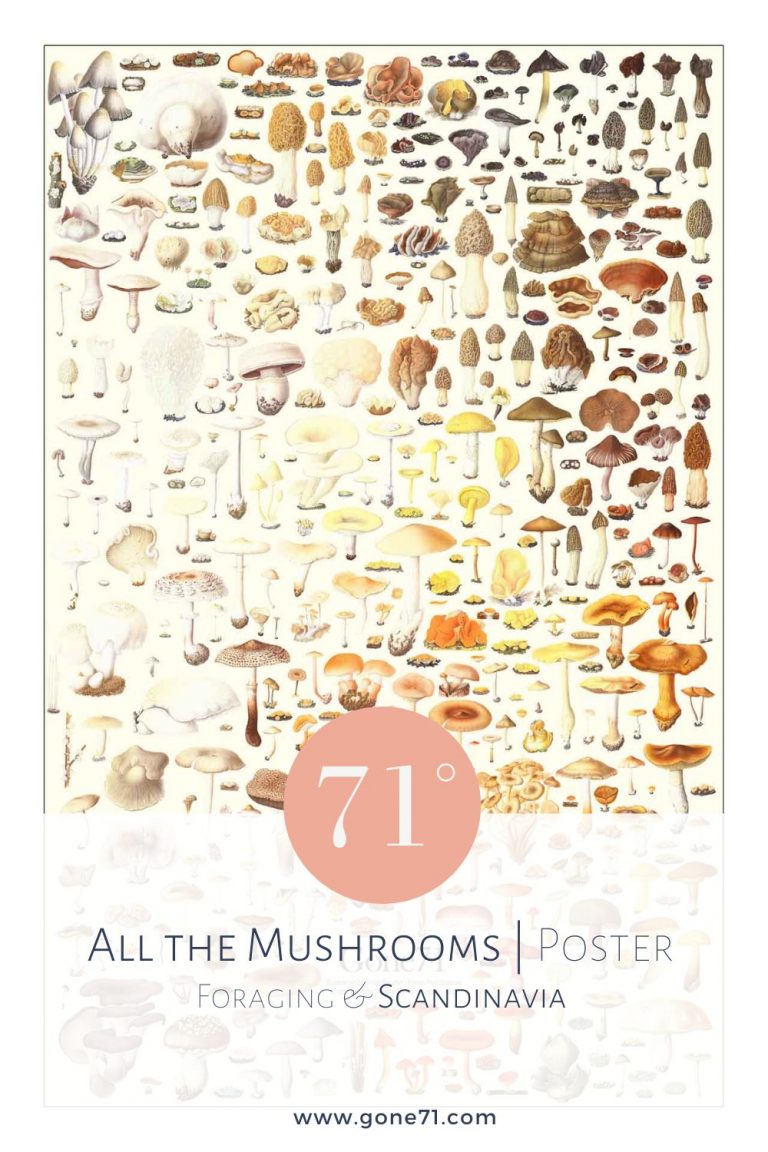Foraging mushrooms
Picking mushrooms is a great way for free and delicious food. With sheer endless forests and suitable habitats many European countries are a paradise for every mushroom hunter and those who like to forage their own food.
- porcini | Boletus edulis
- golden chanterelle | Cantharellus cibarius
- funnel chanterelle | Craterellus tubaeformis
- parasol mushroom | Macrolepiota procera
- bay bolete | Imleria badia
- birch bolete | Leccinum scabrum
- orange birch bolete | Leccinum versipelle
- fly agaric | Amanita muscaria
- phanter cap | Amanita pantherina
- deathcap | Amanita phalloides
- blusher | Amanita rubescens
- caesar’s mushroom | Amanita caesare
The most important thing when it comes to picking mushrooms is that you know and identify all species 100 percent correct. With literally thousands of different species this is not always an easy task and being very careful in the identification process is one of the top priorities.
Many of the culinary highlights in the mushroom family have poisonous or at least inedible counterparts with severe consequences upon consumption. Especially species from the Amanita family as the deathcap (Amanita phalloides), the destroying angle (Amanita virosa) or the panthercap aka false blusher (Amanita pantherina) have a reputation for deadly encounters.
There is no margin for errors and experiments when foraging mushrooms as wild food source.
Fortunately, some of the best mushroom species in the world can be found throughout Europe and especially in the Scandinavian wilderness. Once you know how to pick the right ones they can make for tasty meals along your journey.
Following are some of the most delicious along with some of the most poisonous mushroom species you can find throughout Europe.
Everybodies darlings!
Boletus edulis (cep, penny bun, porcini)
syn.: Cep | swe.: Stensopp | nor.: Steinsopp | fin.: Herkkutatti | dt.: Steinpilz, Herrenpilz
hat: 10 – 20 cm
months: June – November
colours: light brown, brown cap | white-brown stem
characteristic: massive, bulbous trunk and (light) brown cap
habitat: pine-, spruce- and mixed forest
taste: hazelnut
smell: pleasant
This is an example of a delicates mushroom you are welcome to pick in many European forests.
The young mushrooms have a firm, thick and in bent cap. In older specimen the hat develops a plane form and can grow up to 25 cm in diameter. The colour can have various shades of brown. In early stages they have white firm pores which change their colour to yellow and in late stages even to a greenish tone with considerably softer pores and flesh.
One main characteristic is the massive bulbous, pear shaped trunk that usually features a fine light brown netlike pattern.
Boletus are very popular mushrooms and marked prices of 50+ € per kg are common. However fellow mushroom enthusiasts are not the only ones you are up against when looking for boletus. This mushroom is also very popular amongst insects, snails and also other mammals as (rein)deer or wild boar. In many cases you will encounter specimen that are already besieged by worms or partly eaten by snails. You can simply clean these parts out and eat the unaffected ones if possible. Even though some people consider the worm-infested parts of the mushroom as additional source of proteins you should not eat them. The worm excretions are considered toxic and will do you no good.
One of the best ways to prepare porcino is to slice them in (4 mm thick) slices, spice them with salt and pepper and fry them in olive oil or put them on the grill. They are also exquisite in soups and sauces. Even though they are best served fresh they are very suitable for drying to use them at a later stage for soups and other dishes.
Danger of confusion: Boletus edulis can be easily confused with the Tylopilus felleus better known as bitter bolete or bitter tylopilus. This mushroom looks very similar with usually a slightly thinner and darker stem and lighter cap. The pores develop a slightly pinkish tone especially in older specimens. If you are not sure the easiest way to identify this mushroom is its strong bitter taste. Bitter bolets are not poisonous but even a small amount is enough to ruin your whole dish. Make sure to leave them in the forest.
Find more detailed information about Porcini in our porcini guide.
↓↓↓
Cantharellus cibarius (Chanterelle)
swe.: kantarell | nor.: kantarell | fin.: kantarelli, keltavahvero | dt.: Pfifferling, Eierschwammerl
diameter: up to 10 cm
months: June – October
colours: golden yellow, bleach yellow, egg yellow
characteristic: fruity smell, striking yellow colour
habitat: mossy coniferous and mixed forest
Chanterelles – the yellow gold
Chanterelle is considered the yellow gold of the forest and among the most sought after mushrooms in the world with very high market prices in some countries. The striking yellow colour along with its pleasant sweet smell makes it rather easy to identify them and a delicates in every kitchen.
The colour of the Chanterelle can vary between golden-, bleached- or egg yellow. Young specimens have usually curled up edges and in later stages these develop to a more wavy form. Chanterelles are fairly common in Central- and Northern Europe and depending on altitude and latitude they can usually be found from June to October.
The main habitats in Europe are mossy coniferous or mixed forests. Since their roots develop a symbiosis with tree roots (mycorrhiza) they need some form of forest environment to grow.
Our favourite way to prepare them is to simply fry them in olive oil and add some salt. Enjoy them plane, with bread or as a side dish! They are very rich in vitamins (C, D) and wholesome minerals.
Find more detailed information about Golden chanterelles in our guide.
↓↓↓
Craterellus Tubaeformis (funnel Chanterelle, yellowfoot)
swe.: trattkantarell | nor.: traktkantarell | fin.: suppilovahvero | dt.: Trompetenpfiffreling
hight: 3 – 10 cm
cap diameter: 2 – 6 cm
months: July – October
colours: golden yellow, bleach yellow, egg yellow
characteristic: fruity smell, striking yellow colour
habitat: mixed forest
smell: mild, fruity
consumption: cooked
Craterellus tubaeformis or yellowfoot is an excellent edible mushroom and a close relative to the chanterelle. Funnel Chanterelle have a stronger taste than their yellow counterparts and are very popular especially throughout Scandinavia.
The yellowish-brown trumpet shaped mushroom is usually hollow down the middle. Its gills are slightly lighter than the colour of the cap. With a height up to 10+ cm and a cap diameter of up to 7 cm it is slightly smaller and also more fragile than its golden counterpart. It usually grows in big amounts later in the year.
It is very suitable for drying and preservation. The fresh mushrooms are also excellent for frying or in soups and sauces.
Find more detailed information about Funnel chanterelles in our guide.
↓↓↓
The good
Macrolepiota procera (parasol mushroom)
Swe.: Stolt fjällskivling | Nor.: stor parasollsopp | Fin.: ukonsieni | Dt.: Parasol, Riesenschirmling
cap diameter: 3 – 30 cm
height: 8 – 40 cm
months: July – October
colours: light brown with brown soft scales | white to light brown trunk base with darker pattern.
characteristic: white ring that can be shifted easily
habitat: mixed forest, forest edges,
taste: nutty, pleasant
smell: nutty, pleasant
Parasols are the big boys on the table and a very saught after mushroom. With a cap diameter of up to 30 cm and a hight up 40 cm these mushrooms are among the biggest edible mushrooms in general. Due to their massive appearance they are easy to identify. However, since there are some (very) poisonous lookalikes like the Macrolepiota Venenata, Macrolepiota Puellaris, the Lepiota Fulvella (deadly) or the Lepiota Kuehner (deadly) make sure to identify them properly.
One of the most important characteristics is the moveable ring around the stipe. If the ring can not be moved, it is not a parasol or any other relative from the macrolepiota family! Before growing to its full size the young parasols is very compact and egg shaped with the ring still connected to the outer edges of the cap. In this stage you can loosen the ring with your fingernails and try to move it. If you are not a hundred percent certain do not eat it! In older specimen the caps grow almost flat revealing the white gills. The flesh and gills of the parasol can develop a slightly pinkish tone.
Due to its taste and size parasol mushrooms are very popular in kitchens throughout Europe. One of the most popular ways to prepare them is breaded and fried in oil or butter. Other recipes include ragout, stuffed young parasol cups or fried parasols.
Find more detailed information about Parasol mushrooms in our guide.
↓↓↓
Boletus badia / Imleria badia (Bay bolete)
Swe.: Brunsopp | Nor.: Svartbrun rørsopp | Fin.: ruskotatti | Dt.: Maronen Röhrling
cap diameter: 3 – 15 cm
height: 5 – 12 cm
trunk diameter: 1 – 5 cm
months: July – October
colours: (dark) brown smooth cap | brownish trunk, yellow pores.
characteristic: pores of mushroom turn greenish-blue upon contact
habitat: mixed forest, coniferous forest
taste: nutty, pleasant
smell: nutty, pleasant
consumption: cooked
Bay boletes are highly regarded as edible mushrooms in many European kitchens, especially the younger specimen. It is often compared to it’s distant relative the cep (Boletus edulis) but milder in taste.
Its main features are a brown to dark brown cap with fine creamy-yellow pores, which turn darker yellow to olive with age. Upon pressure the pores develop a distinct greenish-blue colour. The stipe is similar to the one of the cep but with longitudinal ridges as well as slimmer and more cylindrical.
Apart its nutty pleasant taste, the mushroom is said to gather high amounts of Caesium and excessive consume is not recommended. In smaller quantities (under 10 kg a year) it should not be problematic. However, everyone has make this decision for him- or herself but for children and pregnant people we do not recommend this mushroom.
Bay boletes are exquisite and suitable mushrooms for drying and will refine every meal. They are also excellent fried in butter or olive oil, also in combination with other mushrooms.
Find more detailed information about Bay bolete in our guide.
↓↓↓
The Leccinum family
This group of mushrooms consists of 75 different species and some of them are extremely common and popular in northern Europe. Since there are so many different species, even experienced mushroom enthusiasts and mycologists can have a hard time to identify the exact species. If you travel through Finland, Sweden or Norway you are likely to encounter species like the brown birch bolete (Leccinum scabrum), the orange birch bolete (Lecinum versipelle), the aspen bolete (Leccinum auranticum) or Mottled bolete (Leccinum variicolor).
All mushrooms from the Leccinum family are edible and many are appreciated in kitchens throughout Europe. However, newer studies suggest that they should be cooked/heated for at least 15 minutes or otherwise raw consumption can lead to (severe) digestion problems and nausea.
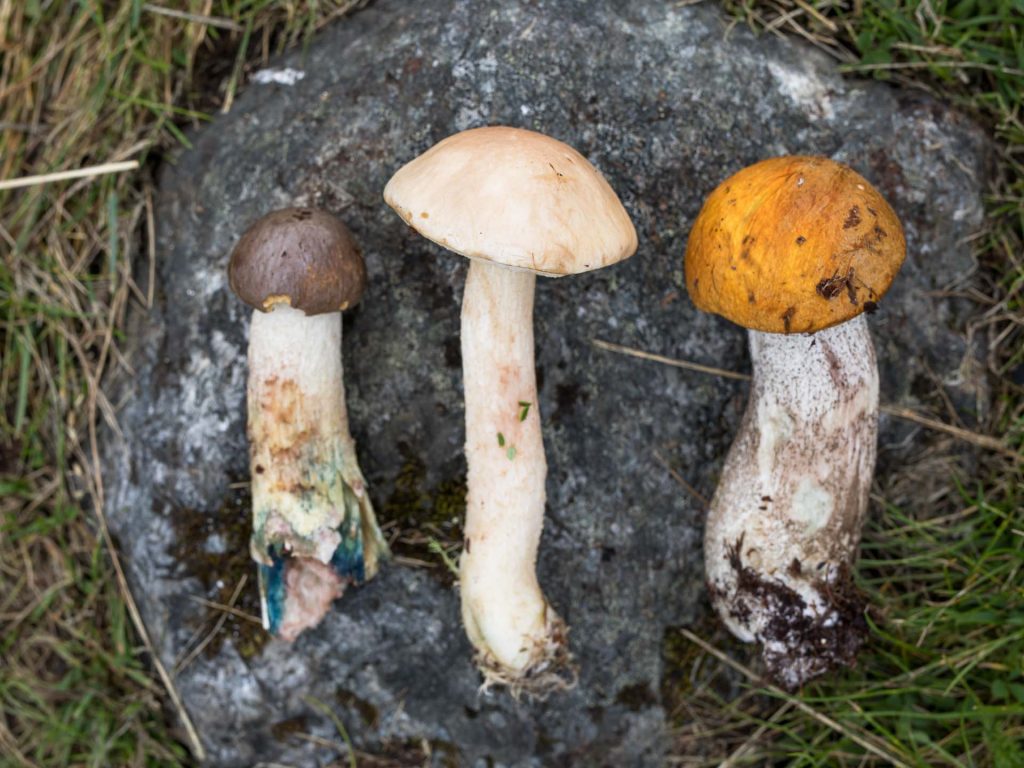
Leccinum scabrum (brown birch bolete, scaber stalk)
swe.: björksopp, strävsopp | nor.: brunskrubb | fin.: lähmentatti | dt.: Birkenpilz
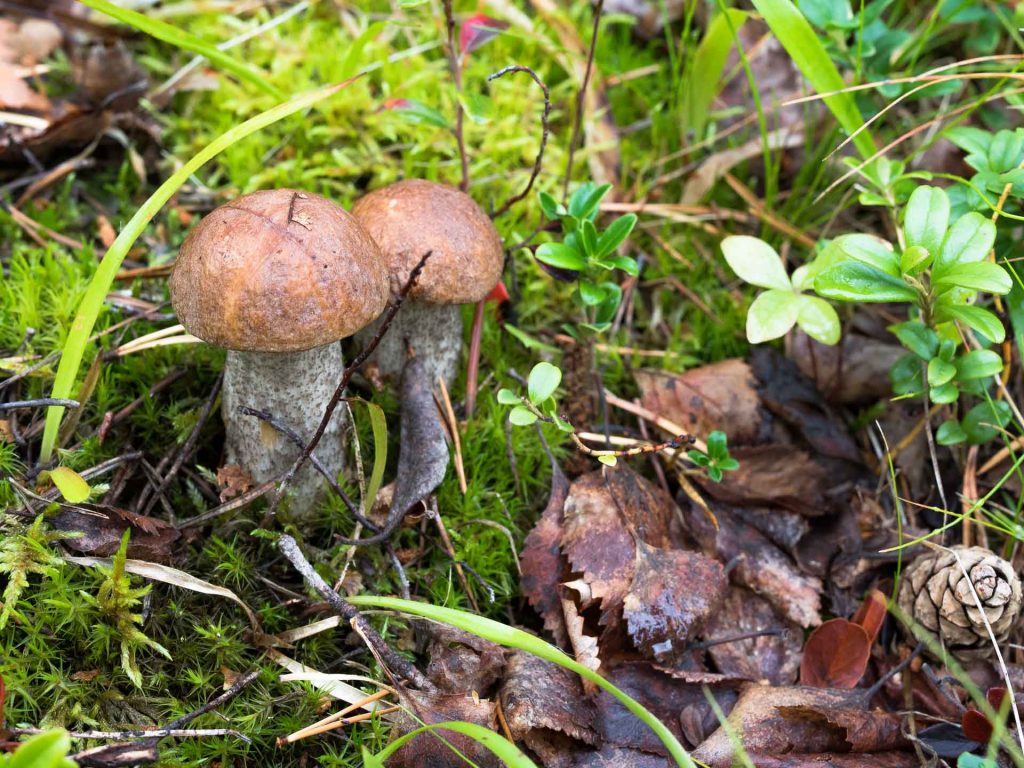
height: 10 – 20 cm
cap diameter: 5 – 15 cm
trunk diameter: 1 – 3,5 cm
months: June – October
colours: brown cap | white-brown trunk.
habitat: birch forest
smell: mild, pleasant
consumption: cooked
Brown birch boletes are among the most common mushrooms you are likely to encounter throughout Norway, Sweden and Finland. Especially the fresh and young specimens are popular in the (northern) European kitchen. Since it is so widely distributed and common this is one of the mushrooms you should definitely know when you travel the northern realms and looking for food to forage.
The cap grows between 5 and 15 cm in diameter and has usually a light brown colour. Birch bolets can grow up to 20 cm in height. Pores are white in younger specimen and become grey in a later stage. When cut the mushroom turns slightly grey. Upon cooking the colour changes to dark grey.
Among very close relatives to the brown birch bolete are:
Find more detailed information about the Birch bolete in our guide.
↓↓↓
Leccinum variicolor (mottled bolete)
swe.: fläcksopp | Nor.: Flammet skælrørhat | Fin.: nokitatti | Dt.: Vielfärbender Birkenpilz, Blaufärbender Birkenpilz

The mottled bolete is edible and a close relative to the brown birch bolete. One of the main distinctive features is the strong blue colour of the flesh developed upon pressure or when cut.
Unlike other birch boletes the ghost bolete stands out with a total white appearance. It is edible though not considered as tasty as other members of the Leccinum family.
Leccinum versipelle (orange birch bolete)
Swe.: Tegelsopp, tegelröd björksopp | Nor.: Rødskrubb| Fin.: koivunpunikkitatti | Dt.: Birken-Rotkappe
height: 15 – 25 cm
cap diameter: 10 – 30 cm
trunk diameter: 1 – 3,5 cm
months: June – October
colours: orange cap | white-grey trunk (black scales)
habitat: birch forest, mixed forest
smell: mild, pleasant
consumption: cooked
As the name indicates the orange birch bolete is a close relative to the brown birch bolete featuring an orange cap. There are several different species in the Leccinum family like the also very common orange oak bolete (Leccinum quercinum). Orange boletes are considered tastier than their brown relatives.
The mushroom features a firm stem with characteristic black scales. The pores are greyish in younger specimen but grow lighter when older. The caps can grow up to 30 cm in diameter with the biggest specimens being also the most bleach ones.
The mushroom turns black upon cooking and considered slightly toxic if consumed raw so proper cooking (15 minutes plus) is required. However, they make for a tasty meal and since they are so common they make for some of the most important mushrooms for foraging in the northern countries. They are very mild in taste and can be used along with other mushrooms like chantarelles in sauces, soups or fried.
Very similar species to the orange birch bolete that differ slightly in appearance and usually form a symbiosis with different types of trees like, spruce, oak or aspen are:
Find more detailed information about the Birch bolete in our guide.
↓↓↓
Leccinum pinophilus (orange bolete var.) | Foxy bolete
swe.: Tallsopp | nor.: Furuskrubb | fin.: Männynpunikkitatti | dt.: Fuchsrotkappe, Kiefernrotkappe
The foxy bolete is an other form of the orange bolete that shares most of its characteristics with the orange birch bolete. The most distinct features are a slightly darker cap and a lighter trunk with white or light grey scales.
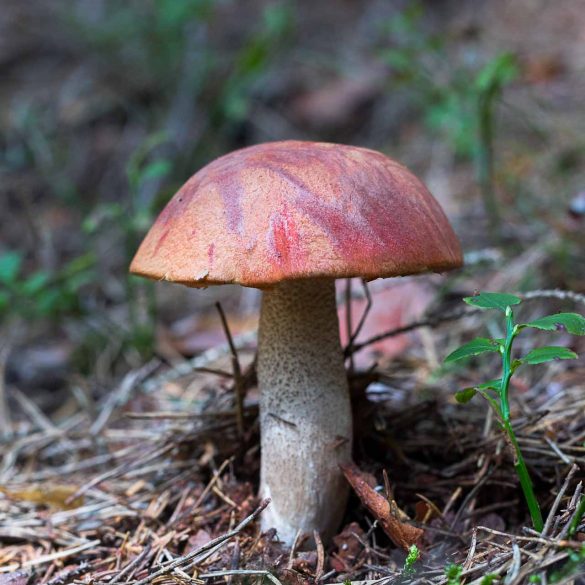
Leccinum aurantiacum (orange bolete var.)
swe.: aspsopp | nor.: ospeskrubb | fin.: lehtopunikkitatti | dt.: Espenrotkappe
Also an other form of the orange bolete is Leccinum aurantiacum. The most distinctive features are a slightly is an almost white stiple and its appeareance in decidious forests.
All bolets are edible as long as not consumed raw due to a high content of xerocomic acid! A cooking time of 15 to 20 minutes is recommended.
The “don’t touch me” category
The Amanita family
This is with no doubt the most intriguing but also the most dangerous and lethal mushroom family. The fly agaric (amanita muscaria) might be the most popular representative of this family but the lethal ones are others. There are also several species that can serve as a delicious meal but before you even consider picking those you have to really know what you are doing since mistakes can easily end in death.
Amanita muscaria (fly agaric)
Swe.: Röd flugsvamp| Nor.: Rød fluesopp | Fin.: punakärpässieni| Dt.: Fliegenpilz
height: 10 – 20 cm
cap diameter: 25 cm
months: July – October
colours: red cap with white scales
characteristics: white ring on stem, colour with white scales
habitat: mixed forest, pine trees
smell: mild, pleasant
consumption: poisonous
Not many mushrooms have a reputation that is so fascinating and daunting at the same time. Tales, myths and legends have been woven around the fly agaric. Ritual consumption of the mushroom can be traced back thousands of years and upon all its bright red appearance is very pleasant to watch.
Against most believes consumption of fly agaric will most probably not kill you. There are no proven deaths that can be traced to the consumption to fly agaric over the last hundred years. However it is still very poisonous and will give you a hell of a time if consumed raw. Despite different toxins it contains the psychoactive substances muscimol and ibotenic acid.
If parboiled at least twice the toxins and psychoactive substances within the mushroom are broken down making it even suitable for kitchen use. However, if you are roaming the northern realms you should consider other types of mushrooms for alimentation and leave this one as an eye candy in the forest where it belongs.
Red fly agarics have a mycorrhizal relationship with pine trees and are a very good indicator for boletus edulis better known as porcino. Very often you’ll encounter them in the same spot close to each other. So if you see a fly agaric, watch out for some porcino.
A northern variation from the red fly agaric is the Brown fly agaric.
Amanita muscaria var. regalis (Fly agaric var.)
Swe.: Brun flugsvamp | Nor.: brun fluesopp | Fin.: ruskokärpässieni | Dt.: Königsfliegenpilz, Brauner Fliegenpilz
The brown fly agaric is mainly a colour variation of its red sibling with the same properties and characteristics.
Amanita pantherina (panthercap, false blusher)
swe.: Panterflugsvamp | nor.: panterfluesopp | fin.: pantterikärpässieni | dt.: Pantherpilz
height: 6 – 14 cm
cap diameter: 6 – 12 cm
months: July – October
colours: brown, yellow-brown, olive-brown cap with white scales
characteristics: white ring on stem, colour with white scales
habitat: mixed forest, sandy ground
smell: mild, pleasant
consumption: deadly
The panther cap is a very poisonous and dangerous specimen from the Amanita family that is responsible for at least some deaths. Some who survived a culinary encounter report from a mild, nutty taste. Usually this mushroom is confused with the edible blusher (Amanita rubescens) – a mistake that can be fatal. The appearance can also resemble the brown fly agaric.
One main difference to the blusher is that the flesh does not turn pink if cut or broken. A second characteristic is, that the white ring is smooth and usually hanging while the blusher has a highly grooved ring.
Amanita phalloides (deathcap)
[swe.: Lömsk flugsvamp | nor.: grønn fluesopp | fin.: kavalakärpässieni | dt.: Grüner Knollenblätterpilz]
height: 5 – 15 cm
cap diameter: 3 – 17 cm
months: July – October
colours: brown, yellow-brown, olive-brown cap with white scales
characteristics: white ring on stem, sometimes white scales
habitat: deciduous forest, mixed forest, parks
smell: no smell, ammoniac, sweet
consumption: absolute deadly
The deathcap is one of the most poisonous mushrooms out there and responsible for the most mushroom related deaths. 20 grams are usually already lethal. It is often mistaken with mushrooms from the Russula family e.g. Russula Cyanxantha or Russula Aerguinea. Sometimes they are also growing in the same area as champignons (Agarius campestris) so you have to make sure to always control the colour of the gills. Deathcaps and their relatives always have white gills while field mushrooms (champignons) usually have pinkish, grey gills.
A very close relative with similar lethal properties is Amanita virosa.
Amanita virosa (destroying angel)
Swe.: Vit flugsvamp | Nor.: hvit fluesopp | Fin.: valkokärpässieni| Dt.: Weisser Knollenblätterpilz, Kegelhütiger Knollenblätterpilz
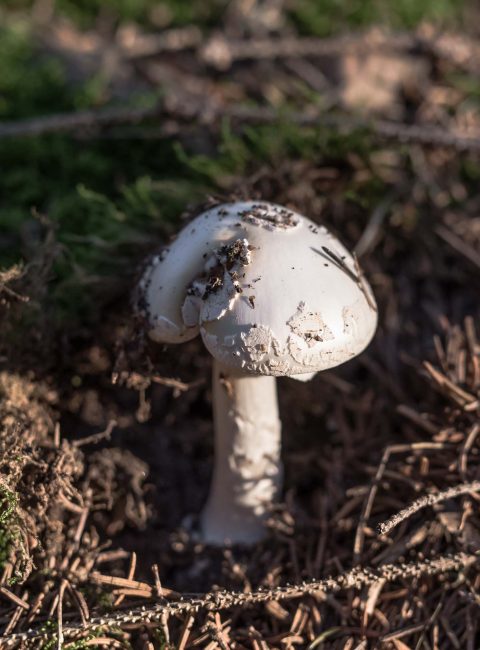
The destroying angle is another one of the absolutely lethal mushrooms out there. Due to its white appeareance it can easily be confused with other white mushrooms e.g. from the family Agaricus.
Amanita citrina (false deathcap)
Swe.: Vitgul flugsvamp | Nor.: gul fluesopp | Fin.: keltakärpässieni | Dt.: Gelber Knollenblätterpilz
The false death cap is not as lethal as its two close relatives Amanita virosa anmd Amanita phalloides but still very poisonous.
For all of these mushrooms goes without saying: don’t even think about tasting them! If you are ever in doubt with any mushroom leave them. This can not be stated often enough.
Amanita rubescens (blusher)
Swe.: Rodnande flugsvamp | Nor.: rødnende fluesopp | Fin.: rusokärpässieni| Dt.: Perlpilz
height: 5 – 15 cm
cap diameter: 3 – 15 cm
months: July – October
colours: white flesh (turning pinkish upon pressure), pinkish to redbrown hat, grey scales
characteristics: white, pinkish ring on stem, grey scales, changes colour upon pressure
habitat: deciduous forest, mixed forest, parks
smell: neutral, mild, raw potatoes, soil
consumption: edible (after cooking)
Apart from the many poisonous and lethal species which the Amanita family contains, it also holds some edible and even delicious species. One common and widespread species is the blusher, named after its tendency to get a pinkish colour upon pressure or when cut or broken.
The stem is firm and stable with a bulging foot. The ring is white or pinkish usually hanging and grooved. The cap is usually reddish-brown to pinkish and has grey-white scales.
Be very careful not to confuse it with the deadly panther cap aka false blusher (Amanita pantherina). This is one of the most common and fatal mistakes. In younger stages of development confusion with the red or brown fly agaric (Amanita muscaria (var. regalis)) is also possible. In order to pick this mushroom with confidents you have to know what you are doing. Otherwise consequences can be severe.
For kitchen use young specimen are most suitable.
Amanita caesarea (Caesar’s mushroom)
Swe.: kejsarflugsvamp | Nor.: keiserfluesopp| Fin.: keisarikärpässieni | Dt.: Kaiserling
height: 7 – 17 cm
cap diameter: 3 – 12 cm
colours: yellow to red-orange cap (like a fly agaric without scales)
characteristics: young specimen are completely covered in velum
habitat: deciduous forest, mixed forest, parks
smell: pleasant, nutty
consumption: edible (raw)
And finally a honourable mention to a very elusive delicates from the Amanita family – the caesar’s mushroom. This representative can usually be found in southern and parts of Europe and is not typical for Scandinavia. However to rehabilitate the poisonous Amanita family we want to mention this highly sought after mushroom here as well. Amanita caesarea ranks upon the most expensive and exquisite mushrooms in the world.
The young specimens are completely covered in the velum and it can have an appearance like hatching from an egg. It can easily be mistaken for a red fly agaric or also a death cap which makes it delicate to pick. However, finding one is a special moment in every mushroom hunters career. And with an on going shift in the continental climate we may see this delicacy sooner or later more frequently in the northern realms.
This mushroom is one of the view that is considered a delicacy when eaten raw with olive oil. In other recipes they are sliced very fine and fried in butter or olive oil.
Take a look on our mushroom poster “All the mushrooms”
↓↓↓
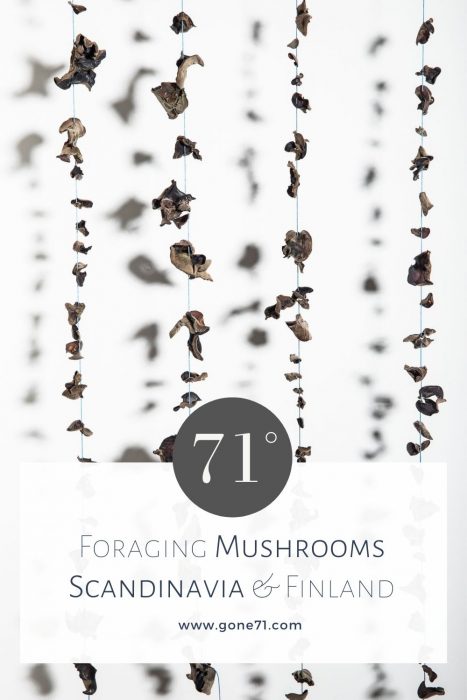
We have compiled this overview with the best of knowledge and belief, but do not claim to be complete and reserve the right to make errors.
Learn more about poisonous mushrooms and mushroom poisons here
↓↓↓

